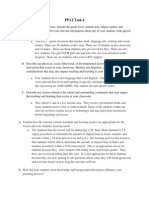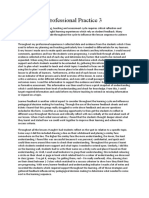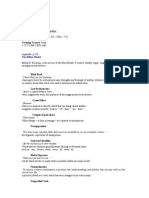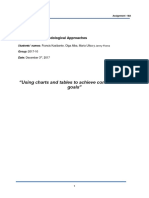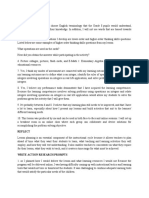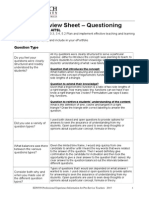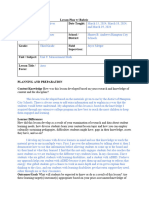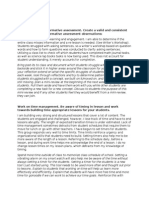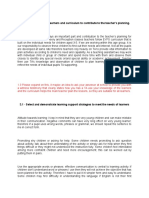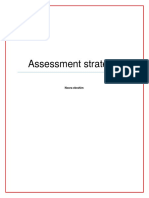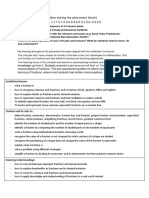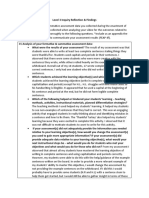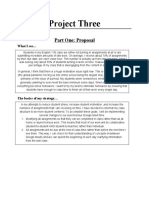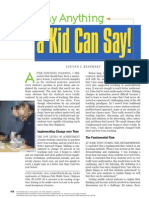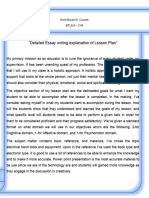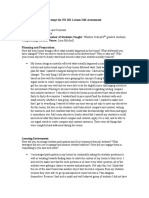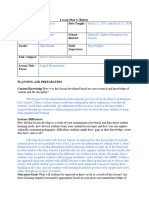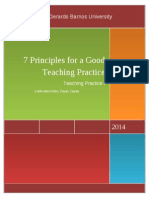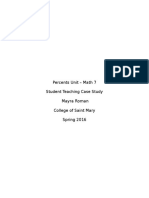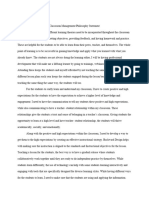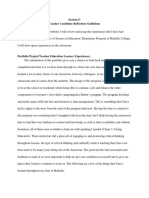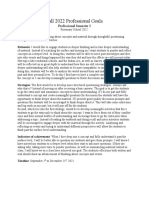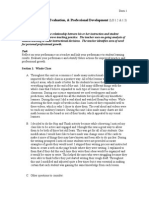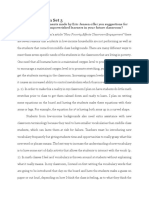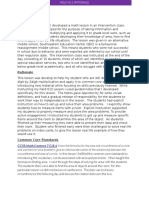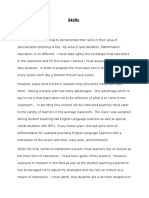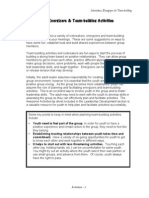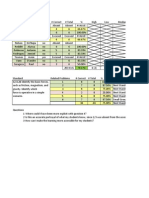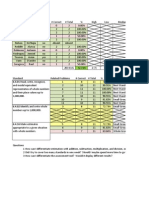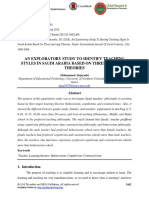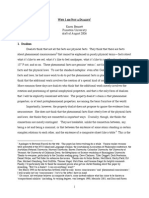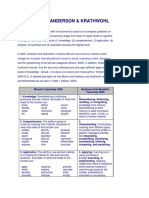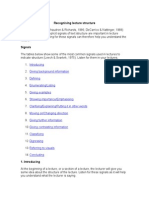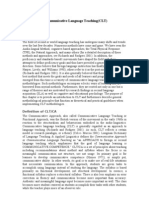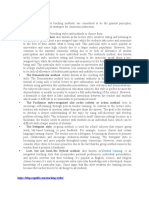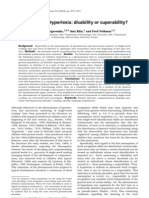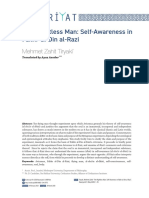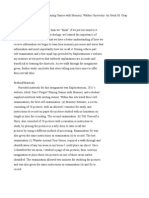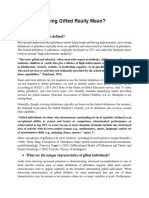Professional Documents
Culture Documents
Planning Commentary
Planning Commentary
Uploaded by
darnelllogan8Original Description:
Copyright
Available Formats
Share this document
Did you find this document useful?
Is this content inappropriate?
Report this DocumentCopyright:
Available Formats
Planning Commentary
Planning Commentary
Uploaded by
darnelllogan8Copyright:
Available Formats
Knowledge of Students to Inform Teaching Academic Development: To be successful with gaining the knowledge and skills to do well on these
concepts, students will need a few pre-requisite skills/tools. Students will have to know what true and false number sentences are, students will need to be able to compute simple addition, subtraction, multiplication, and division facts, and be able to use a calculator to perform the simple. My students have already gone over true and number sentences and will only need a quick refresher on this topic. Basic fact skills are low, but students know the process of computing simple facts with a calculator. Students will be thinking in a different way with this new topic. Not only will they be dealing with a new topic in math, but they will be regrouping and performing new operations with parentheses, beginning the order or operations. Academic Language Development: Students are very good with obtaining new vocabulary in my classroom. What my co-resident, mentor teacher, and I do in the class to reinforce the concept of new vocabulary is making our students use it in all of our talks about math. It is mandatory for students to focus on using vocabulary as they answer questions and talk/work during think pair share (TPS). The vocabulary is important, so students can recognize what it is they will be seeing in exit tickets and high stakes testing (assessments). Family/Community/Cultural Assets: Family and community arent as important in this aspect of the lesson. Students dont have to pull from their personal experiences to be successful in this lesson. The only recall or transfer that is necessary is from previous facts and lessons gone over since August. The students who
are very enthusiastic and interested in classes are pretty much the higher performing students, and it starts with their parents. Regardless of the community they have grown up in, their parents are often working with them to make sure their homework is done and that they have a decent understanding of what they are supposed to do to succeed in class. Expectations from the parents are high and those expectations have been displayed through the children. There are many exceptions to this rule. But there is often someone who influences their lives who has a positive impact in a students schooling and their success in school. There are a few students who do not feel as confident in their mathematical or social abilities. In this instance, I give them opportunities during lower level thinking activities or during lower level tactile activities. I also pose guided questions to them during TPS, so they can feel more confident about sharing their responses to raise their hands. Social and Emotional Development: Social and emotional development is big in my classroom. Students have learned for the most part how they are supposed to act and conduct themselves at all times during classroom instructional time, but it still has to be modeled for them sometimes. Redirection and refreshers of behavior has to be done for the students. During the lesson there is a lot of TPS, individual think time, collaboration, during the we do, and moving around during sharing. Learning Strategies: Direct instruction on the rug is a major point of focus for my stud ents, because thats where they can learn the skills needed to do well on the tasks at hand. Discussion is another strategy that works well for my students. We use a lot of TPS in the classroom, to get students thinking and talking about math. Following discussions and direct instruction, my students need
practice and lots of it. Students vary in the pace where things are grasped, which is why practice is used as a check for understanding. We were taught by my mentor to provide multiple checks for understanding to create the best environment of success for our students. These strategies may be used to address misconceptions as checks for understanding. This gives me the chance to cold call and even use slates to see what my students know and misconceptions they may have, so I can address them and push them forward in the learning process.
Supporting Student Learning Understanding of Student Prior Learning: I know practice and direct instruction is big for my students learning and understanding of concepts in class. With this being known, I have to give multiple attempts for practice during the instructional we do portion of the lesson. But I also have to plan checks for previous learning to build off of, to make sure students have grasped previous concepts, before we can move on. I plan these checks for previous knowledge during math reflexes and math message. These initial checks let me see what my students already know and where I will have to scaffold during instruction. Sequence of Instructional Plan(s): During the lesson there are constant checks for understanding; not only for the new material. Before a new topic can be covered I have planned a check for understanding for the previous two lessons, because what I will be teaching builds on the same concept of true and false number sentences. I have an advanced concept of identifying and calculating true and false
number sentences along with regrouping to make number sentences true. After a concept is taught, it must be checked for understanding. Skill Connections: Throughout the learning process, students have an essential question to think about during activities and discussions. For this specific lesson the essential question was How do I know what operation to perform first, in a number sentence? The question is to help students make connections from the previous concepts learned to what they will be learning during my lesson. The lessons are structured for students to make these connections. Many times I like to bring the complete connection in at the end of the lesson wrap up, unless a student can make the connection providing for a great teaching moment. I want my students to be able to make connections between performing operations randomly to performing them in a structured process. Also I want them to make the connection of how and why performing operations in this structured manner is important. Misconceptions for Students: Some misconceptions for students are knowing when to perform certain operations either before parentheses or after them. Students have previously learned you perform operations from left to right. Now when a parenthesis is on the right hand side of a number sentence, students have to remember they are to perform the operation inside the parenthesis before any other operation in the number sentence. Another misconception for my students will be solving number sentences with the sentence on the right hand side of the equal sign (eg. 12 = (6 2) * 3). Students are often used to solving number sentences with the computational numbers on the left hand side of the equal sign. Lastly, students will run into solving
computational algorithms on both sides of the equal sign at the same time. This is a concept students have not done in class yet. They will have to be guided through this process. Planned Instructional Strategies for Support: There are no planned instructional strategies in place to support students with specific learning needs. I have made sure my directions for tools and skills are as clear and explicit as possible, so these questions will not arise. Also, my students who have IEPs have minutes outside of the classroom, and are not in the classroom during this instructional time. They receive additional strategies from our excellent special education resource teacher.
Supporting Student Understanding and Use of Academic Language Key Academic Language: The language demand of this lesson is very important. The students will not be able to properly gain the new skills needed to perform the tasks if key academic language is not gained and used during instruction, discussions, and TPS. The academic language is all integrated in the actual planning of the lesson and must be used to obtain all necessary skills. The assessment and checks for understanding is based off of key academic language, because thats what students have seen during NWEA testing and what students will see during ISAT. Key language is important used in all facets of the lesson. This key language is not limited to vocabulary. It is also the structure of the questions asked of students during we do and independent practice. It is important to allow students to practice now, things they will see in the winter and sprint, during high stakes testing. Instructional Supports:
Planned instructional supports such as TPS, whole group discussions, and paired discussions, are in place to help students think about math and make connections with vocabulary and actual content knowledge. Discussion and think time has been placed in specific parts of the lesson to allow students to make the connections using critical thinking and prior knowledge to understand new content. These tools are very important because it allows me to check for understanding and see what my students understand and see what misconceptions my students have. Once I know what my kids know and what they have misconceptions with, I can scaffold the new learning to make sure they obtain knew knowledge and skills by the end of the lesson.
Monitoring Student Learning Assessments: Informal: There are multiple informal checks for understanding in place to help me gage where my students are in the learning process for this lesson. I have oral checks for understanding with explanations for students to give reasoning behind their answers. Students will also use TPS to share and come to a consensus about their responses and share out with the class. Cold call is a good way to keep students engaged and ready to share responses from their discussions. This informal assessment helps me see if I need to have more modeling during I do or we do. I was specifically looking to see if my students were able to get the process of ordering operations properly (i.e. parentheses first). Formal:
There are many forms of formal assessments I have planned for this lesson. I have half sheets of paper for students to leave the rug. If students do not get off the rug, they are here for my small group instructional group to help them catch up with the rest of the class. I have also provided multiple practice problems for my students to share responses with partners and whole class. Lastly, I have an exit ticket to check the three different phases of the lesson we will be covering during this lesson. The exit ticket is the formal assessment that will be recorded and used for additional small group instructional later in the unit. Modifications and Accommodations: Modifications made for to the assessment for students with specific needs to display their understanding of the material is a reduced formal assessment. The assessment is 6 questions and students with specific needs will only be graded on half of the assessment questions. Many times, these students are coming in from the resource room around assessment time, and they need more time to complete the same tasks as their able bodied/mind peers. If necessary, students will have extended time to complete the problems to level the field for them.
You might also like
- Ppat Task 4Document7 pagesPpat Task 4api-122157048100% (1)
- FEAPs PortfolioDocument3 pagesFEAPs Portfoliochelsea2310No ratings yet
- Professional Practice 3 JustificationDocument2 pagesProfessional Practice 3 Justificationapi-555558629No ratings yet
- Emotional Intelligence - New Perspectives and Applications PDFDocument300 pagesEmotional Intelligence - New Perspectives and Applications PDFJonas Araujo De Avila CamposNo ratings yet
- Book - Training TrancesDocument5 pagesBook - Training TrancesReeshabhdev Gauttam100% (1)
- Methodological Approaches Group 3 Final VersionDocument9 pagesMethodological Approaches Group 3 Final VersionJenny MarcelaNo ratings yet
- FS 2 Episode 10Document5 pagesFS 2 Episode 10karen marie dela pasionNo ratings yet
- Educational PhilosophyDocument6 pagesEducational Philosophyapi-344760154No ratings yet
- Edn550 Eportfolio 2b Observations v1Document11 pagesEdn550 Eportfolio 2b Observations v1api-280114661No ratings yet
- Task 2 Reflection T.ThompsonDocument3 pagesTask 2 Reflection T.ThompsontreygtNo ratings yet
- Unit 9 - Measurement Lesson Plan 4Document5 pagesUnit 9 - Measurement Lesson Plan 4api-607301023No ratings yet
- Unit 9 - Measurement Lesson Plan 5Document5 pagesUnit 9 - Measurement Lesson Plan 5api-607301023No ratings yet
- artifactsfs2WPS OfficeDocument5 pagesartifactsfs2WPS OfficejuliopajacNo ratings yet
- TlacDocument7 pagesTlacapi-299178329No ratings yet
- Psi GoalsDocument3 pagesPsi Goalsapi-295355929No ratings yet
- Unit 9 - Measurement Lesson Plan 3Document5 pagesUnit 9 - Measurement Lesson Plan 3api-607301023No ratings yet
- Mrs. SatchwellDocument5 pagesMrs. SatchwellManixNo ratings yet
- Standard 4 Artifact ReflectionDocument2 pagesStandard 4 Artifact Reflectionapi-238727715No ratings yet
- Assessment DescriptionDocument6 pagesAssessment Descriptionapi-244472956No ratings yet
- Robertson Planning CommentaryDocument21 pagesRobertson Planning CommentarybrrobertNo ratings yet
- Reflection and Self TwsDocument2 pagesReflection and Self Twsapi-241237474No ratings yet
- Tpa Activity 3Document3 pagesTpa Activity 3api-480040176No ratings yet
- Math Reflective Lesson (Wright)Document3 pagesMath Reflective Lesson (Wright)TiaraMilesNo ratings yet
- Level 3 Inquiry Part 4Document7 pagesLevel 3 Inquiry Part 4api-576899685No ratings yet
- Level 3 Inquiry Part 4Document7 pagesLevel 3 Inquiry Part 4api-576899685No ratings yet
- Obrian Erin - Project ThreeDocument6 pagesObrian Erin - Project Threeapi-548087287No ratings yet
- Reflection in Response To FeedbackDocument5 pagesReflection in Response To Feedbackapi-349579702No ratings yet
- A Kid Can Say!Document6 pagesA Kid Can Say!api-255505576No ratings yet
- SchemaDocument1 pageSchemaapi-180875253No ratings yet
- NaumannpgpDocument4 pagesNaumannpgpapi-283467120No ratings yet
- Cosare KB EDUC2 FinalRequirementsDocument4 pagesCosare KB EDUC2 FinalRequirementsKent Bryan CosareNo ratings yet
- University of La Verne Induction Program Contract P 1Document5 pagesUniversity of La Verne Induction Program Contract P 1api-341729694No ratings yet
- EDIM 508 Unit 3 Summary Posting Information Overload: The Need For The Synthesizing MindDocument5 pagesEDIM 508 Unit 3 Summary Posting Information Overload: The Need For The Synthesizing MindktitraceNo ratings yet
- Observed Lesson Self-AssessmentDocument4 pagesObserved Lesson Self-Assessmentapi-305785129No ratings yet
- Miaa 330 Demonstration of Advanced PracticeDocument5 pagesMiaa 330 Demonstration of Advanced Practiceapi-245618390No ratings yet
- Work Lesson PlanDocument6 pagesWork Lesson Planapi-310504510No ratings yet
- Unit 9 - Measurement Lesson Plan 2Document5 pagesUnit 9 - Measurement Lesson Plan 2api-607301023No ratings yet
- 7 Principles For A Good Teaching Practice: Capitan General Gerardo Barrios UniversityDocument8 pages7 Principles For A Good Teaching Practice: Capitan General Gerardo Barrios UniversityCarla ZayasNo ratings yet
- ST Case StudyDocument30 pagesST Case Studyapi-312091622No ratings yet
- Classroom Management Philosophy StatementDocument3 pagesClassroom Management Philosophy Statementapi-744351255No ratings yet
- Danielle Ruff Intasc Standard 8: Instructional Strategies: What Is This Artifact?Document3 pagesDanielle Ruff Intasc Standard 8: Instructional Strategies: What Is This Artifact?Danielle ruffNo ratings yet
- Section 5Document9 pagesSection 5api-419249079No ratings yet
- Professional GoalsDocument4 pagesProfessional Goalsapi-528034851No ratings yet
- Tws 8 DornDocument4 pagesTws 8 Dornapi-176703960No ratings yet
- Section 5 PortfolioDocument7 pagesSection 5 Portfolioapi-547409083No ratings yet
- Reflection and Self-EvaluationDocument5 pagesReflection and Self-Evaluationapi-241287310No ratings yet
- January 11, 2016 4 Grade Stem: Effective Questioning in STEM ProjectsDocument5 pagesJanuary 11, 2016 4 Grade Stem: Effective Questioning in STEM Projectsapi-317739244No ratings yet
- Math Workshop ModelDocument6 pagesMath Workshop ModelJillBellamyNo ratings yet
- Dice DIce Baby Activity and Practice Quiz Lesson Observation 3Document12 pagesDice DIce Baby Activity and Practice Quiz Lesson Observation 3Victoria WarrenNo ratings yet
- Final Requirements IN Teaching Math in The Primary Grades: Submitted By: Amparado, Jollie CDocument7 pagesFinal Requirements IN Teaching Math in The Primary Grades: Submitted By: Amparado, Jollie CJollie AmparadoNo ratings yet
- Section OneDocument8 pagesSection Oneapi-417799551No ratings yet
- Observation PrimaryDocument12 pagesObservation Primaryapi-294960766No ratings yet
- Journal 3Document6 pagesJournal 3api-483286695No ratings yet
- Goal Setting Evaluation and Rubric USF Elementary EducationDocument4 pagesGoal Setting Evaluation and Rubric USF Elementary Educationchelsea2310No ratings yet
- Decimals UnitDocument10 pagesDecimals Unitapi-251198450No ratings yet
- Morena Lemus Self - Reflexion About A Good Teaching PracticeDocument10 pagesMorena Lemus Self - Reflexion About A Good Teaching PracticeMorena LemusNo ratings yet
- Professional Growth Plan 2016Document12 pagesProfessional Growth Plan 2016api-242345831No ratings yet
- TMS3725 Assignment 04 (Portfolio) PDFDocument7 pagesTMS3725 Assignment 04 (Portfolio) PDFMbiselo TshabadiraNo ratings yet
- RationaleDocument4 pagesRationaleapi-352784801No ratings yet
- Section 6Document5 pagesSection 6api-469878907No ratings yet
- SkillsDocument3 pagesSkillsapi-341108813No ratings yet
- activities.pdf თამაშები, ენერჯაიზერებიDocument16 pagesactivities.pdf თამაშები, ენერჯაიზერებიPaata Alaverdashvili100% (1)
- Final Reflection PaperDocument8 pagesFinal Reflection Paperdarnelllogan8No ratings yet
- EPS 541 Planning PaperDocument2 pagesEPS 541 Planning Paperdarnelllogan8No ratings yet
- Aggregated Data 2-8-13Document3 pagesAggregated Data 2-8-13darnelllogan8No ratings yet
- Assessing Student LearningDocument6 pagesAssessing Student Learningdarnelllogan8No ratings yet
- Aggregated Data 2-8-13Document3 pagesAggregated Data 2-8-13darnelllogan8No ratings yet
- Aggregated Data 1-18-11Document3 pagesAggregated Data 1-18-11darnelllogan8No ratings yet
- Aggregated Data 2-1-13Document3 pagesAggregated Data 2-1-13darnelllogan8No ratings yet
- Math Tuesday DailyDoublePlan 4-7Document2 pagesMath Tuesday DailyDoublePlan 4-7darnelllogan8No ratings yet
- Santiago Penagos Consuegra. Cod: 2131300: Gabe ZichermannDocument2 pagesSantiago Penagos Consuegra. Cod: 2131300: Gabe ZichermannSantiago P. ConsuegraNo ratings yet
- An Exploratory Study To Identify Teaching Styles in Saudi Arabia Based On Three Learning TheoriesDocument13 pagesAn Exploratory Study To Identify Teaching Styles in Saudi Arabia Based On Three Learning TheoriesGlobal Research and Development Services100% (1)
- Cognitive and MetacognitiveDocument2 pagesCognitive and MetacognitiveJomel CastroNo ratings yet
- Baby TalkDocument3 pagesBaby TalkAndreea CiotNo ratings yet
- Bennett, Karen - Why I Am Not A DualistDocument26 pagesBennett, Karen - Why I Am Not A DualistMaríaMaríaNo ratings yet
- Bloom and Anderson & KrathwohlDocument4 pagesBloom and Anderson & KrathwohlSo LenNo ratings yet
- Menin & Schiavo - Rethinking Musical Affordances PDFDocument16 pagesMenin & Schiavo - Rethinking Musical Affordances PDFTomás CabadoNo ratings yet
- Recognising Lecture StructureDocument10 pagesRecognising Lecture StructureGraciela RapNo ratings yet
- Multisensory Approach Presentation - 1Document15 pagesMultisensory Approach Presentation - 1mahesh thampiNo ratings yet
- Communicative Language Teaching (CLT)Document17 pagesCommunicative Language Teaching (CLT)Bishnu Pada RoyNo ratings yet
- Unit 3a Listening 1 Listening Sub Skills and A Typical LessonDocument6 pagesUnit 3a Listening 1 Listening Sub Skills and A Typical LessonDonovan Ramon MartinezNo ratings yet
- Teaching Vocabulary Using Scrabble Game For Junior High SchoolDocument8 pagesTeaching Vocabulary Using Scrabble Game For Junior High SchoolTaruli ElbinaNo ratings yet
- The Evolution and Psychology of Self-DeceptionDocument56 pagesThe Evolution and Psychology of Self-DeceptionЛиля Буторина100% (1)
- Alderson-Day-2015-Inner Speech - DevelopmentDocument35 pagesAlderson-Day-2015-Inner Speech - DevelopmentWangLeixianNo ratings yet
- What Are Teaching StylesDocument6 pagesWhat Are Teaching StylesFanya HandayaniNo ratings yet
- Hyperlexia: Disability or Superability?Document15 pagesHyperlexia: Disability or Superability?jumbleberryNo ratings yet
- Learner Variables Important For Success in L2 Listening Comprehension in French Immersion ClassroomsDocument23 pagesLearner Variables Important For Success in L2 Listening Comprehension in French Immersion ClassroomsJordan ExecNo ratings yet
- Kindergarten Readers Workshop Lesson 1Document8 pagesKindergarten Readers Workshop Lesson 1api-448771701No ratings yet
- The Flightless Man: Self-Awareness in Fakhr Al-Din Al-Razi: Mehmet Zahit TiryakiDocument39 pagesThe Flightless Man: Self-Awareness in Fakhr Al-Din Al-Razi: Mehmet Zahit TiryakiMuhammad AfiqNo ratings yet
- Language, Communication, & SchizophreniaDocument3 pagesLanguage, Communication, & SchizophreniaJavier AndrésNo ratings yet
- Situated LearningDocument5 pagesSituated LearningEn-En Caday Tindugan BautistaNo ratings yet
- In Defence of Modesty - John McDowellDocument23 pagesIn Defence of Modesty - John McDowellPabloRivasRobledoNo ratings yet
- Introduction To Psychology: Playing Games With Memory - by Heidi M. GrapDocument2 pagesIntroduction To Psychology: Playing Games With Memory - by Heidi M. GrapHeidi GrapNo ratings yet
- Detailed Lesson Plan With Psychological ImplicationsDocument26 pagesDetailed Lesson Plan With Psychological ImplicationsToffee Perez100% (12)
- Edu102 Report 2ndsemDocument8 pagesEdu102 Report 2ndsemCharmaine Anjanette Clanor LegaspinaNo ratings yet
- Bautista, Jamille V. Bautista, ShanelDocument28 pagesBautista, Jamille V. Bautista, ShanelJamille Victorio BautistaNo ratings yet
- Experimental Psychology Experiment Proposal Working Title: ExperimenterDocument5 pagesExperimental Psychology Experiment Proposal Working Title: ExperimenterZymon Andrew MaquintoNo ratings yet
